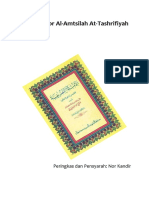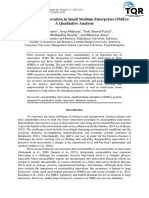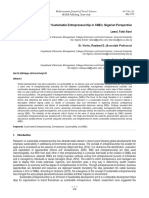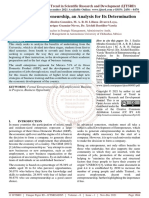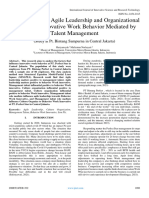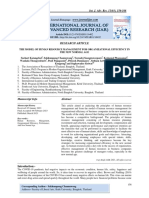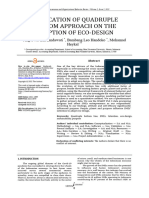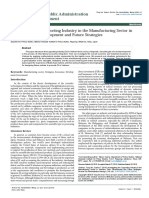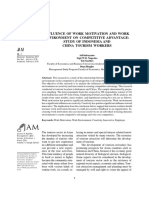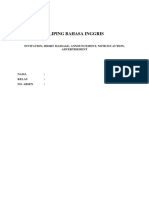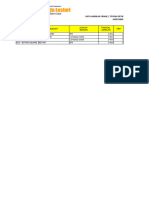Professional Documents
Culture Documents
Keywords:-Employment Conditions, Welfare Facilities
Original Description:
Original Title
Copyright
Available Formats
Share this document
Did you find this document useful?
Is this content inappropriate?
Report this DocumentCopyright:
Available Formats
Keywords:-Employment Conditions, Welfare Facilities
Copyright:
Available Formats
Volume 7, Issue 12, December – 2022 International Journal of Innovative Science and Research Technology
ISSN No:-2456-2165
Questioning the Effect of Employment Conditions,
Welfare Facilities and Middle Managers in
Lime Stone Mining Activities of Pt. Tonasa
Cement Indonesia, Tbk. from A Japanese
Management Style Perspective during
Covid-19 Pandemic and the New Normal Era
Hariyono Gunawan
Magister Sains Manajemen,
Universitas Hasanuddin, Makassar,
Indonesia
Idayanti Nursyamsi Nurdjanah Hamid
Professor of Human Resource Management, Associate Professor of Human Resources Management,
Universitas Hasanuddin, Makassar, Universitas Hasanuddin, Makassar,
Indonesia Indonesia
Abstract:- This article employed a documentation Indonesia, Tbk. (TCI).
analysis and in-depth observation techniques on the
situation faced by one of the biggest limestone mining The internationalization of business and the emergence
companies, PT. Tonasa Cement Indonesia, Tbk. (TCI). of multinational companies have been major trends in recent
Employment conditions and welfare facilities become the years. Indonesia as one of the countries located in South
focus of this article as they influence employee East Asia has also attracted many foreign companies to
performance in the said company. Nevertheless, during establish their business there. Some of them are Japanese
the primary data gathering, we found some conflicting foreign companies. The Indonesian Foreign Japanese
aspects that need to be addressed directly by the Human company as a comparison to the subject of this studyadapts
Resource Division and Board of Directors. The article their organizations according to their worldwide
closes with some summary and recommendations that involvement and strategies.
we think would contribute to the field of Human
Resource Management to build a strong case study and In the process of sustaining TCI’s future in this
thorough qualitative analysis on the subject related to circular economy, we advise TCItoadoptthe uniquenessof
employment conditions, welfare facilities, and middle the Indonesian Foreign Japaneseand their Japanese-style
managers. management alongwith their global organization structure
within TCIs daily organizational activities. A critical review
Keywords:- employment conditions, welfare facilities, of the literature both sourced from Japanese and English
employee performance, middle managers, Japanese-style have revealed the conceptual framework of this study by
management, an Indonesian mining company, PT Tonasa looking at the unique Japanese-style management and some
Cement Indonesia Tbk. current issue that evolved around its practices in Japan
which are believed might influence TCI practices. The
I. INTRODUCTION nature & importance of Japanese middle managers in
Japanese today’s corporations is thus discussed. A
The covid-19 pandemic haspassed, however, the preliminary review of various management approaches is
remnant of the virus known as Omicron still exists in also discussed. Finally, an identification of the problem is
Indonesia. The recent cases of Omicron infection are clarified and our analysis andresults of this qualitative study
catching Indonesian’s society attention as the mass media are presented.
and social media tend to report them regularly. This has put
the Government of Indonesia (GoI) in this New Normal Era Dyna (1972) explained that multinational organization
to re-advise Indonesian citizens on the wear of face masks, primarily deals with the ways of establishing the internal
hand sanitiser, etc, relationships of authority, responsibility, communications,
and control of a company to achieve its basic purposes and
This article employs a qualitative method analysis to objectives. It also determines the functional and other
unearth our primary research question on how employment interrelationships among people within the firm to manage
conditions and welfare facilities affected employee and perform the work of the enterprise. The organization
performance in the biggest lime mining company in the sets up the structure for decision-making within a company
Eastern Provinces of Indonesia, PT Tonasa Cement
IJISRT22DEC410 www.ijisrt.com 2207
Volume 7, Issue 12, December – 2022 International Journal of Innovative Science and Research Technology
ISSN No:-2456-2165
and strives to blend decision-making with specialized II. OBJECT AND PURPOSE OF THE STUDY
expertise on a variety of short and longer-range problems
that a company encounters. Before going deeper to explain the above statement,
we strongly believe we need to look back to the role of a
Thus, multinational companies want to anticipate and middle manager in Japanese history. According to
influence their future rather than be victims of it. They want Hasegawa (1985), middle managers are as indispensable to
to use their corporate resources – management, personnel, the existence of Japanese corporations as food and air are to
technical and business know-how, funds, and other assets – human beings. When Japan entered the mainstream of
more efficiently and productively. Managers as one of the international affairs in 1868, middle managers played a
company resources are the most important central central role in assimilating and introducing the foreign
component which guides its companies to achieve its expertise – technological, economic, political, and military –
previously stated purposes and objectives. needed for the modernization of Japan.
It is a recognized fact that managers play a crucial role The situation after World War II was similar, for the
in today’s global industrial society. Megginson (1963) nation was once again starting from scratch. With the defeat,
pointed at the contribution of managers to economic the middle manager that had devoted themselves to the war
development by saying: “...it is becoming evident that one of effort now turned their energies to the task of reconstruction.
the main reasons for this fantastic economic development At first, many were jobless; the majority soon found
has been the vitality, energy, and practical intelligence of the employment in private industry. Driven by the need to earn
men who have managed it...”. their keep, as well as by a professional sense of
responsibility, they tackled the arduous job of resurrecting
Industrial growth contributes significantly to the the nation’s industry. This sense of dedication and
economic development and the civilization of the country. commitment to the job is so prevalent in Japanese
Industrial growth depends a great deal upon the abilities and companies that it endows them with a special atmosphere, in
skills of the managers in managing their national or which work takes precedence over private life.
multinational industrial corporations. Farmer and Richman
(1965) state: “We view management as the single most This atmosphere we believe can repeat itself today and
critical social activity in connection with economic progress. we believe the crucial role of middle managers in guiding
Physical, financial and manpower resources are by TCI to cope with the problem back home in Japan and
themselves passive agents; they must be effectively successfully operating its business outside its own country is
combined and coordinated through sound, active dispensable if their companies are to survive the financial
management if a country is to experience a substantial level crisis of today’s economy.
of economic growth and development. A country can have
sizeable natural and manpower resources including plentiful Thus, we choose to study middle management atTCI
skilled labour and substantial capital but still, be relatively for several reasons, they are:
poor because very few competent managers are available to The crucial and unique role of the middle manager. He
put these resources efficiently together in the production and has to translate objectives and policies coming from top
distribution of useful goods and services.”. management in operational terms. Implements and
supervises plans and decisions. Compresses the data
Today, before the recent financial crisis in Asia coming from lower levels of the organization and from
followed by Japan (Akira, 1999), a question arises about outside the company in forms useful for upper-level
how Japan’s competitive edge will stay on top and how will decision-making. Coordinates the available resources and
TCI particularly will cope with this problem and succeeds in sustains the effective functioning of the organization.
the future. Apart from the entire problem that Japanese The middle manager has the opportunity to be promoted
company must face back in the homeland, an assessment of to key positions and top management positions
management candidates for a middle management position responsible for making crucial decisions concerning the
are still one of the most crucial roles even when it is adjustment and development of the business organization
operating in a foreign country. in an ambiguous and ever-changing environment.
This call for research, then, will try to cover the object III. CONCEPTUAL FRAMEWORK
and purpose of our study, shortly after this introduction. We
also try to discuss the conceptual framework of this study by A. Japanese-Style Management
looking at the unique Japanese-style management and some As have been known, lifetime employment (shushing
current issue that evolved around its practices in Japan that Koyo), seniority system (Renkojoretsuseido) and company-
we believe might influence TCI practices. The nature of based welfare facilities (kigyo-nai future Kosei) are three
Japanese middle managers in Japanese today’s corporations main customs that have been developed over the principle of
will also be explained. A preliminary review of various managerial familyism (keieikazoku-shugi) in Japanese
management approaches is discussed. Finally, an companies as a result of the deep-rooted corporate
identification of the problem is clarified and our plan of philosophy of Japanese-style management (Economics,
study is presented. Business & Management Encyclopedia, 1992; Kodansha
International Japanese Encyclopedia, 1990).
IJISRT22DEC410 www.ijisrt.com 2208
Volume 7, Issue 12, December – 2022 International Journal of Innovative Science and Research Technology
ISSN No:-2456-2165
This philosophy then makes Japanese companies B. Middle Manager
mainly practice annual employment of new graduates and Stoner & Freeman (1992) define that middle
not offer middle management positions to people from management as a term that covers a variety of management
outside its companies based on its lifetime employment & positions between supervisors (lower management) and top
seniority system. However, as shown in a study by Urata & management. The middle management position is a position
Hara (1995) explaining that is not the case regarding: not belonging to the board of directors, reporting to a
A 1988-1989 survey by the Japanese Ministry of Labor managing director or a general manager, and is above the
indicates some of the following actual hiring situations: position of first-line supervisors. Small organizations
(1) a survey on Japanese company’s rate of employees usually do not have any middle managers, but large and
who have experience working for other companies reveals medium-sized organizations may have several layers of
that mid-career hiring is high among Japanese companies, middle management.
especially in manufacturing, real estate, transport, and
communication industries; (2) when examine by company As a consequence, a middle manager will have either a
size, Japanese large-sized companies show the high rate of top manager or another middle manager from a higher level
mid-career hiring when compared to small and medium- – in large or medium-sized organizations, as his superior. He
sized companies. will have one subordinate or more, but not in a large
A survey on “important points emphasized in the number. His subordinate is always a manager, either another
promotion to middle managers” by the Japanese Institute middle manager from a lower level or a supervisor (a
of Personnel Survey in 1990-1991 shows, that the manager from a lower management position).
simplistic picture of Japanese companies being seniority-
According to Hasegawa (1986) candidates for middle
based cannot be applied. A survey indicates that
management positions in Japanese companies are from
competency-based factors such as “administrative ability”
inside their own companies, they are:
and “contribution to the company” hold the top positions,
Newly hired graduates of top universities, whom the
and the rates of stressing seniority factors, such as “age”
company hopes will prove their mettle in intracompany
are low in present Japanese companies.
competition, and
Thus from these surveys, we can assume that among The pool of men, occasionally women, who have shown
Japanese large-sized companies dominantly in that they are capable of holding a managerial post despite
manufacturing, real estate, transport, and communication the lack of college education.
industries rising a need to hire candidates for middle
management positions from outside their companies, while In addition, candidates for middle management
utilizing the in-house talent already available by promoting positions also can be recruited from outside the company
it to middle management positions. such as:
Mid-career employees (chute saiyosha). They are usually
Regarding this assumption, Kazuo (1996) explained skilled workers with specialized training who either are
that contrary to popular belief of the lifetime employment scouted by companies ‘in need’, have quit their former job
practice of recent graduates hiring as the primary source of or have become jobless due to, for example, bankruptcy.
new employees among Japanese companies, he observes Their specialist skill is often highly regarded, but their
that many of the new employees are now from other status in the organization is remarkably lower than that of
companies or as categorized by him as “job changers” their colleagues of the same age group as can be seen in
employee. Based on the Survey of Employment Mobility General Council of Trade Unions of Japan (Soho) news
(Koyo DokoChosa) by the Japan Ministry of Labor, shows (White Paper on The 1980 Spring Struggle, 1980). They
that the percentage of recruits from other companies frequently can improve their position by switching to
exceeded the percentage of recruits from recent graduates. another company despite their lower status, and
Even among male workers at large companies, “job ‘Descent from heaven’ employees (amakudari). This is a
changers” outnumber recent graduates and are an senior bureaucrat who has retired from central
overwhelming majority at small and medium-sized government positions and continued to be hired as a
companies. management executive in private industry. The aim is to
take advantage of bureaucratic know-how, familiarity
Furthermore, an assumption rise from Urata & Hara’s with government procedures, and personnel connections.
surveys that Japanese company is leaving their seniority
system to promote people to a middle management position Azumi (1969) states four ingredients in a successful
and become more dependent on the competency or ability of recruitment and selection policy, they are:
their people. This assumption is supported by Professor A clear conception of the kind of work for which
Tsuchiya Moriaki& Konomi Yoshinabu’s opinion in their candidates are to be chosen, together with the qualities
book “Shaping the Future of Japanese Management: New and qualifications needed to carry it out,
Leadership to Overcome the Impending Crisis”. According Knowledge of where to look for possible recruits,
to them, the new hidden assets – the ability of Japanese Knowledge of how to look for them, and
company employees – must be acquired and developed if Means of recognizing and assessing the candidates
Japanese companies want to survive the impending crisis of presenting themselves with the qualities and qualifications
today. sought.
IJISRT22DEC410 www.ijisrt.com 2209
Volume 7, Issue 12, December – 2022 International Journal of Innovative Science and Research Technology
ISSN No:-2456-2165
This study supported Hasegawa’s (1986) view. Why the delay?
According to his book, Japanese Style Management:
“Today, however, the selection and training process is beset Of the several reasons mentioned by various
with stumbling blocks. The growth in the size of Japanese management authors, one seems to be the main reason. In
corporations makes it difficult to evaluate the growing the Middle Age, business was held in low esteem, it was
number of candidates for managerial positions. The regarded as a degrading occupation (Koontz, O’Donnel,
inevitable tendency is to standardize procedures and make Weihrich, 1986; Kast & Rosenzweig, 1974). These
them impersonal. This usually leads to placing stress on unfavourable climates begin to change in the 19th century.
seniority and de-emphasizing ability. Once this approach The Protestant ethic and the emerging spirit of capitalism
makes headway in a company, there is an erosion of vitality contributed to the growing emphasis on scientific
and morale, with a consequent loss in the ability to compete investigation and technological application in Western
in the marketplace.” societies. At the beginning of the 20th century, the climate
was favourable for the development of management as a
Furthermore, he pointed out that misjudgments in science. After the civil war in the U.S. large-scale industrial
middle management promotions can threaten a company’s development took place. The industrial revolution, with its
very existence. With the recent slowdown in the economy, emphasis on the technology of production, utilization of
the demand for middle managers is on the decline. The machinery, and the factory system, required the collective
situation has given rise to a class of employees dubbed the organization of men and resources.
“window-side tribe”, a term that refers to middle-aged
workers, who, having failed repeatedly to be promoted to a After the work of Taylor and other members of the
middle management position, simply remain with the scientific management school, management became a
company, sitting in a nice sunny spot by an office window subject of study to many scholars. After the Great
with nothing meaningful to do. Depression in 1929 and after World War II, management
theories developed like mushrooms.
Also according to the author, there is a growing trend
among employees of large companies who fear that they Until present, management theories can generally be
may one day join the “window-side tribe” to consider divided into five. The scientific management school; the
moving while they are still young enough and flexible administrative management theory; the human relations
enough to make the change. Smaller companies welcome movement; the operation research or management science;
such people, especially if they are technicians. Although the and the system approach to management.
phenomenon is still limited for the most part to technicians,
there are signs that it will extend to other classes of workers Because the assessment of management candidates as
who have specialized professional skills. Should this a management activity cannot be studied in isolation,
movement gain momentum the effects on security and independent of other management activities within the
lifetime employment, generally considered the most industrial organization. Thus we believe that a systematic
characteristic features of Japanese-style managerial approach is the most appropriate approach to studying this
practices, are bound to be devastating. problem, especially in the identification of potential middle
managers in TCI.
This restlessness among employees seems to be
focused on those who filled middle management positions in D. Identification of the Problem
large-sized companies. Moriwaki and Yoshinobu (1997) Although there will always be a risk in recruiting people,
explained that middle manager displeasure over the present the risk in positioning “the right middle managers in the
conditions in their company due to the bureaucratized nature right place” should be kept to a minimum as far as possible.
of their firms are possessed of nothing other than the This consideration has to be taken because the decision
prestige of being large. Furthermore, large companies in made by middle managers will have a great impact, either
Japan have become so ponderously structured that they are positively or negatively, on the further operations and
suffocating. Indeed the problem seems to be more complex development of the industrial organizations. Therefore a felt
in large-sized companies and that is where we will need to look for a better or an alternative to the assessment
concentrate our study in the future. method of identifying potential middle managers need to be
developed.
C. The System Approach to Management
Management is a new science with a long history. Thus rise a need to identify potential middle managers
Koontz, O’Donnel, and Weihrich (1986) quoted studies by identifying their common personal attributes and
indicating the attention to and recognizing the importance of leadership capabilities. Managerial effectiveness as an
management in ancient Egypt, China, and Greece. output of management positions needs to be taken into
study. Last but not least, developing a better assessment
No doubt, managerial activities were executed in method to identify potential middle managers needs to be
governmental institutions and industrial organizations since studied in the future.
their existence. Management as science, however, was
founded early at the beginning of the 20th century. With this framework in mind, we organized the
information obtained from a detailed study of Japanese and
non-Japanese literature on the subject and a field study in
several TCIs. Thus the literature will be studied, and
IJISRT22DEC410 www.ijisrt.com 2210
Volume 7, Issue 12, December – 2022 International Journal of Innovative Science and Research Technology
ISSN No:-2456-2165
theories and research results (including the few research representatives of the majority, that the employer should
results on the same subject) relating to the assessment and grant six days annual vacation with pay consecutively and
identification of potential middle managers will be explored extend this number with one day every year after two years
and analyzed: of employment, in total not exceeding twenty days.
to develop comprehensive research projects on the
assessment of management candidates in TCI Based on this legal framework, TCI has designed their
to look for possible alternatives to developing an employment conditions. Based on the documentation
appropriate strategy to identify management candidates analysis, we observe a substantial disparity between top
with good potential for middle management positions in management, medium-level management, and lower-level
TCI. management position in TCI in terms of annual workdays,
holidays, and leave, and the total number of hours worked.
For our study, we choose TCIsubsidiaries around In lower-level management positions, employees work more
Indonesia which can be compared to a Japanese large-sized days than those in top-level management. Overall, they all
company. Because as has been shown earlier, in Japanese lack 6 days of paid leave in comparison to their fellow
large-sized companies dominantly in manufacturing, real enterprises in other lime mining companies.
estate, transport, and communication industries, the
identification of potential middle managers could well be Moreover, a 5-day workweek system has not yet been
better observed. This is not just due to their nature in fully established in TCI. In 2021 only 23.26% of the active
selecting and recruiting but also to the difficulty of employees enjoyed two days weekends every week, while
determining the right assessment practices that can be used the remaining were under schedules of one day off. Active
in the identification of the right potential middle managers. employees are employees that have been selected by the
Human Resources Division at TCI as a few employees that
Surely, the growth in the size of Japanese corporations have been considered to still work during the Covid-19
makes it difficult to evaluate the growing number of pandemic because they have been shot twice or third
candidates for managerial positions (Hasegawa, 1986; Clark, coronavirus vaccines/booster.
1987). Therefore, the development of the right assessment of
management candidates is more important in large-sized Interesting findings, though, appeared who hold their
companies than in medium and small-sized companies. position in middle- and lower-level management. They are
Furthermore, Japanese large-sized companies are believed to very reluctant to change to the 2 days weekend due to the
be more influenced by the financial crisis in Japan today, costs involved and the productivity lost during the Covid-19
thus affecting their management practices. pandemic. Improvement of this situation is very slow
despite pressure from the labour unions, the Human
To categorize the size of TCI we used the Japanese Resources Division, and the General Board of Directors.
law classification category (Paus, 1966). According to
Japanese law, medium and small-size company (chusho- The slow realization of a five day’s work week for all
kigyo) employs not more than 300 persons or are capitalized employees also can be attributed to the high number of non-
at 10 million yen or less. By this legal definition, any scheduled working hours at a time when Covid-19 hits the
company surpassing these lines of demarcation could be Indonesian community very hard with the number of dead
considered a large-size company (dai-Kogyo). tools reaching the highest that year (2021) as the health
facility could not contain more patients along with the fact
IV. ANALYSIS & RESULTS that the virus had spread all over Indonesian and the world
in general. Nevertheless, when the year 2022 comes, the
Employment conditions and welfare facilities are a number of Covid-19 cases suddenly dropped quite
collective term for that provision which we would rank, for significantly after the new vaccine, booster, arrived in
convenience’s sake, as secondary labour conditions. Some Indonesia. This helps the situation become normal again and
of these provisions are law provided and apply to all this era is known as The New Normal for every Indonesian.
industries, while others are optional and differ per company
in scope and content. In this introductory section, we will V. CONCLUSION & FUTURE PLAN OF STUDY
review a part of Indonesia’s social welfare directly about
business enterprises, starting with employment conditions. This article is only the first part of our study in TCI
and how to strive in a circular economy and the forthcoming
Aspects of work, belonging to the sphere of Industrial Revolution 5.0. We plan to begin the future study
employment conditions, such as working hours, recess, with five management theories that will be discussed shortly
holidays, and safety and hygiene measures, are all stipulated in our study. Emphasis will be given to the system approach
in the Labor Standard Law. This Law, the Labor Relations, to management. The system approach views the industrial
has been promulgated by the GoI to be enforced in any organization as an open socio-technical system and
industry, small and big, including TCI. considers all the primary subsystems and their interactions.
It is hoped that it will provide general management
The Labor Standards Law stipulates for instance, that knowledge and serve as a general study frame.
working should not exceed eight hours a day, that the
employer must provide one rest day per week to the worker,
and that the number of working hours can be extended if it
has been agreed upon with the labour union or the
IJISRT22DEC410 www.ijisrt.com 2211
Volume 7, Issue 12, December – 2022 International Journal of Innovative Science and Research Technology
ISSN No:-2456-2165
Later, the object of our study will be the middle REFERENCES
manager and his job. The first part will discuss empirical
studies about management jobs or positions, the second part [1.] Akira, Kojima. Getting to the Bottom of Japan’s
will be devoted to a description of the middle management Economic Blues (JapanEcho). Japan Echo Inc. Vol.26
job using the system approach. No.1, February 1999.
[2.] Azumi, Koya. Higher Education and Business
The concept of managerial effectiveness will be Recruitment in Japan. Teachers College Press. 1969.
discussed, as the difference between efficiency and [3.] Chiaki, Nishiyama. An Emergency Declaration for
effectiveness, and the distinction between apparent, Japan. Japan Echo Inc. Vol.26 No.1, February 1999.
personnel and managerial effectiveness. The main factors [4.] Clark, Rodney. The Japanese Company. Charles E.
determining managerial effectiveness will be elaborated. Tuttle Company, Inc. 1987.
Managerial effectiveness is viewed as the output of a [5.] Dyna, William A. Multinational Business Strategy.
management position. We will focus on the middle McGraw-Hill, Inc. 1972.
management job as a dynamic entity interacting [6.] Economics, Business & Management Encyclopedia.
continuously with the other subsystems. It will deal PT Cipta Adi Pustaka. 1992.
primarily with the output of the middle management job [7.] Eric Jones, Lionel Frost, and Colin White. Coming
(managerial effectiveness), the criteria, and the measures of Full Circle: An Economic History of the Pacific Rim.
output. Westview Press. 1993.
[8.] Farmer, R.N. and B.M. Richman. Comparative
Managers should be leaders, but leaders need not be Management and Economic Progress. Richard D.
managers (Koontz, O’Donnell, &Weihrich, 1986). Several Irwin. 1965.
leadership theories will be explored and analyzed. Are there [9.] Hasegawa, Keitaro. Japanese Style Management.
common personnel attributes possessed by effective leaders Kodansha. 1986.
in the industry? What are the consequences of the theories [10.] Kodansha International Japanese Encyclopedia.
and leadership studies on the identification of potential Kodansha. 1990.
middle managers? [11.] Japan External Trade Organization. Selling in Japan:
The World’s Second Largest Market. JETRO. 1985
Personnel attributes required for effective management [12.] Japanese Government Economic Planning Agency.
are next. Personnel attributes encompass traits (intellectual, The Japanese Economy: Recent Trends and Outlook:
personality, attitudinal traits), knowledge, abilities and 1996. 1996.
skills. Based on a description of a middle management job, a [13.] Japanese Government Economic Planning Agency.
conceptual analysis will be given about the possible personal The Japanese Economy: Recent Trends and Outlook:
attributes required for effective management. Results of 1997. 1997.
empirical studies about personal attributes will be discussed. [14.] Kast, F.E. and J.E. Rosenzweig. Organization and
The objective of management assessment, the Management: A System Approach. McGraw-Hill
assessment tools, the problem of the validity of the tools Kogakusha. 1974.
using the conventional selection model, the assessment [15.] Kazuo, Koike. The Economics of Work in Japan.
centre method, and the role of the assessed or management LTCB International Library Foundation. 1996.
candidate will be dealt with. [16.] Kono, Toyohiro. Strategy and Structure of Japanese
Enterprises. M.E.Sharpe Inc. 1988.
To complete our study we need to study the practice of [17.] Koontz, Harold; Cyril O’Donnel and Heinz Weihrich.
human resources management in TCI and its influences Management. McGraw-Hill. 1986.
internally and externally. Are they Japanese-style or [18.] Thurow, Lester. Head to Head: The Coming
Western-style? Toward globalization or localization? What Economic Battle Among Japan, Europe, and
is the impact of TCI on the Indonesian labour force? America. William Morrow and Company, Inc. 1992.
[19.] McCormick, E.J. and Joseph Tiffin. Industrial
Last, we will try to discuss an alternative selection Psychology. Prentice-Hall Inc. 1974.
model for TCI. Based on the analysis in the previous [20.] Megginson, L.C. Management Selection,
chapter, a model for the selection of assessment research Development, and Motivation in the United States.
will be presented. Apart from this, the possibility of Management International. 1963.
alternative development assessment centres for Japanese
companies in Indonesia in particular to identify and develop
potential middle managers will be elaborated.
IJISRT22DEC410 www.ijisrt.com 2212
You might also like
- History of Banking Asian PerspectiveDocument226 pagesHistory of Banking Asian PerspectiveJohn Sutherland100% (3)
- Menu Remboelan Makanan 2Document13 pagesMenu Remboelan Makanan 2Effendi LimNo ratings yet
- Komodo The Living DragonDocument184 pagesKomodo The Living DragonECL1P53No ratings yet
- Mukhtashor Amtsilah TashrifiyahDocument15 pagesMukhtashor Amtsilah TashrifiyahAhmad el'Farruq as'Shiddiqi100% (2)
- Corporate Universities Landscape and Practice in IndonesiaDocument6 pagesCorporate Universities Landscape and Practice in IndonesiaFulki HouseNo ratings yet
- Article Review: Exploring The Cultural Determinants of Entrepreneurial Success In: The Case of MalaysiaDocument11 pagesArticle Review: Exploring The Cultural Determinants of Entrepreneurial Success In: The Case of MalaysiaMayoNo ratings yet
- Corporate Sustainability in SMEs: An Asian PerspectiveDocument30 pagesCorporate Sustainability in SMEs: An Asian PerspectiveWihelmina DeaNo ratings yet
- InnovationProcessofNaturalResourcebasedFirmsinFour-STIPolicyandManagementJournalIndonesiaVol 2no 1pp 1-1Document15 pagesInnovationProcessofNaturalResourcebasedFirmsinFour-STIPolicyandManagementJournalIndonesiaVol 2no 1pp 1-1salsabila fitristantiNo ratings yet
- HRRolesinaddressingIN4 0Document23 pagesHRRolesinaddressingIN4 0Raka R RamadhianNo ratings yet
- Mutual Learning Between Japanese Managers and Foreign Subordinates Enablers For Middle-Up-Down Management Under Role Definition Flexibility at JapaneDocument20 pagesMutual Learning Between Japanese Managers and Foreign Subordinates Enablers For Middle-Up-Down Management Under Role Definition Flexibility at JapaneDaniel ChristianNo ratings yet
- Handoyo (2021)Document21 pagesHandoyo (2021)VICTOR HUGO SALVATIERRA MANCHEGONo ratings yet
- 5564 ArticleText 9633 1 10 20201127Document17 pages5564 ArticleText 9633 1 10 20201127farizNo ratings yet
- ResearchesDocument7 pagesResearchesAlmira Jane MoradasNo ratings yet
- E'Ship PDFDocument6 pagesE'Ship PDFSunni ZaraNo ratings yet
- Eco-Knowledge Management: A Case Study of Itc Limited: Journal of Shanghai Jiaotong University (Science) April 2022Document13 pagesEco-Knowledge Management: A Case Study of Itc Limited: Journal of Shanghai Jiaotong University (Science) April 2022jesNo ratings yet
- AmrialDocument6 pagesAmrialrizkiNo ratings yet
- Entrepreneurship Development Smes in IndonesiaDocument24 pagesEntrepreneurship Development Smes in IndonesiaMugaahed AlfutaahyNo ratings yet
- OSCM 2019 Paper 49Document10 pagesOSCM 2019 Paper 49Hino Sales IndonesiaNo ratings yet
- 2022 032 Revisão Sistemática Das Barreiras Ao Desempenho Da Empresa Social Usando Uma Estrutura InstitucionalDocument19 pages2022 032 Revisão Sistemática Das Barreiras Ao Desempenho Da Empresa Social Usando Uma Estrutura InstitucionalAndre LuizNo ratings yet
- Sistem Tata Kelola Keuangan Industri Kecil Dan Pengrajin Kayu Sebagai Upaya Penyehatan Dan Pelaksanaan Tanggungjawab SosialDocument10 pagesSistem Tata Kelola Keuangan Industri Kecil Dan Pengrajin Kayu Sebagai Upaya Penyehatan Dan Pelaksanaan Tanggungjawab SosialArif Kenji ShinodaNo ratings yet
- Talent Strategy 1Document8 pagesTalent Strategy 1AzraNo ratings yet
- 1-Sustainability Innovation in Small Medium Enterprises (SMEs)Document16 pages1-Sustainability Innovation in Small Medium Enterprises (SMEs)ymaladaNo ratings yet
- Mangement 1 PDFDocument201 pagesMangement 1 PDFSarat Kumar100% (1)
- Hyundai Motors CultureDocument10 pagesHyundai Motors CultureSubham Sekhar100% (1)
- 10 1108 - Jic 01 2020 0012Document31 pages10 1108 - Jic 01 2020 0012ophelia zungbeyNo ratings yet
- Ardi22 - Predicting Turnover Intention of Indonesian Millennials Workforce in The Manufacturing Industry - A PLS-SEM ApproachDocument15 pagesArdi22 - Predicting Turnover Intention of Indonesian Millennials Workforce in The Manufacturing Industry - A PLS-SEM ApproachMflkhNo ratings yet
- Identify The Factors That Influence Workforce Agility in The Post Covid-19 Pandemic Era: A Systematic Literature ReviewDocument11 pagesIdentify The Factors That Influence Workforce Agility in The Post Covid-19 Pandemic Era: A Systematic Literature ReviewInternational Journal of Innovative Science and Research TechnologyNo ratings yet
- Emerald-CSR-COMDEV-PKBL PekanbaruDocument8 pagesEmerald-CSR-COMDEV-PKBL PekanbaruAbdul ZakirNo ratings yet
- The Mediating Role of Job SatisfactionDocument15 pagesThe Mediating Role of Job SatisfactionhanikaruNo ratings yet
- Millennial Transformational Leadership On Organizational Performance in Indonesia Fishery StartupDocument9 pagesMillennial Transformational Leadership On Organizational Performance in Indonesia Fishery StartupAPPNo ratings yet
- Ical-22 210 446 1 RV PDFDocument9 pagesIcal-22 210 446 1 RV PDFSabari CaNo ratings yet
- Culturas Organizativas para Apoyar La Competitividad de Las PYME en La Industria de La Seda de IndonesiaDocument4 pagesCulturas Organizativas para Apoyar La Competitividad de Las PYME en La Industria de La Seda de IndonesiaLina MarcelaNo ratings yet
- 9120-Article Text-35434-1-10-20160508 PDFDocument9 pages9120-Article Text-35434-1-10-20160508 PDFEswari GkNo ratings yet
- Minor Project 3Document54 pagesMinor Project 3chaitamahajan10No ratings yet
- Human Resource Management As Competitive Advantage in The New MillenniumDocument15 pagesHuman Resource Management As Competitive Advantage in The New Millenniumlistrik jaringanNo ratings yet
- EnterpreneurDocument5 pagesEnterpreneuralif nur irvanNo ratings yet
- Journal Soewarno Dayasaing OrgperformDocument8 pagesJournal Soewarno Dayasaing Orgperformannisa nurawaliaNo ratings yet
- Competitive Pressure and Business Performance in East Java Batik IndustryDocument8 pagesCompetitive Pressure and Business Performance in East Java Batik Industrysamuel sesayNo ratings yet
- Benefits of Entrepreneurship, An Analysis For Its DeterminationDocument5 pagesBenefits of Entrepreneurship, An Analysis For Its DeterminationEditor IJTSRDNo ratings yet
- 13 Ijmres 10012020Document11 pages13 Ijmres 10012020International Journal of Management Research and Emerging SciencesNo ratings yet
- Role of Education in Entrepreneurship DevelopmentDocument10 pagesRole of Education in Entrepreneurship DevelopmentAnoushey FatimaNo ratings yet
- 325 Article 1262 1 10 20210505Document7 pages325 Article 1262 1 10 20210505Nguyễn Thị Phương NhiNo ratings yet
- The Influence of Agile Leadership and Organizational Culture On Innovative Work Behavior Mediated by Talent ManagementDocument12 pagesThe Influence of Agile Leadership and Organizational Culture On Innovative Work Behavior Mediated by Talent ManagementInternational Journal of Innovative Science and Research TechnologyNo ratings yet
- The Model of Human Resource Management For Organizational Efficiency in The New Normal AgeDocument11 pagesThe Model of Human Resource Management For Organizational Efficiency in The New Normal AgeIJAR JOURNALNo ratings yet
- CGOB Paper Revision 2Document17 pagesCGOB Paper Revision 2AmeliaNo ratings yet
- Pengaruh Kerawanan Pangan, Bantuan Pangan Dan Jaminan KesehatanDocument16 pagesPengaruh Kerawanan Pangan, Bantuan Pangan Dan Jaminan KesehatanRandika DwiputraNo ratings yet
- Characterizing Knowledge Management in The Small Business EnvironmentDocument18 pagesCharacterizing Knowledge Management in The Small Business Environmenttedy hermawanNo ratings yet
- ArticleText 37965 1 10 20200617Document11 pagesArticleText 37965 1 10 20200617ngu mahNo ratings yet
- Corporate Governance, Privatisation, and Financial Performance of Indonesian State-Owned EnterprisesDocument22 pagesCorporate Governance, Privatisation, and Financial Performance of Indonesian State-Owned Enterprisesaki murakamiNo ratings yet
- 30534-Article Text-57151-1-10-20210406Document12 pages30534-Article Text-57151-1-10-20210406Niranjan Devkota, PhDNo ratings yet
- Entrepreneurship and The Strategic Transformation of Medium and Small EnterprisesDocument5 pagesEntrepreneurship and The Strategic Transformation of Medium and Small EnterprisesKlara KlaraNo ratings yet
- PublicVsPrivateSectorOnCsrInvestmentsInIndia (475 480)Document6 pagesPublicVsPrivateSectorOnCsrInvestmentsInIndia (475 480)MANAV SAHUNo ratings yet
- Galley ProofDocument16 pagesGalley ProofWAN NUR AZLINA BT IBRAHIM MoeNo ratings yet
- Yanti Koestoer Paper 2007Document11 pagesYanti Koestoer Paper 2007nosweat77No ratings yet
- Social Innovation Drivers in Social Enterprises: Systematic ReviewDocument22 pagesSocial Innovation Drivers in Social Enterprises: Systematic ReviewFajar1978No ratings yet
- Sustainability Kpis For Integrated Reporting: Tomoki Oshika and Chika SakaDocument18 pagesSustainability Kpis For Integrated Reporting: Tomoki Oshika and Chika SakaVidesh FaikooNo ratings yet
- The Role of Indonesian Micro Small and Medium EnteDocument5 pagesThe Role of Indonesian Micro Small and Medium EnteAntonius SiahaanNo ratings yet
- Investigating The Supporting Industry in The Manufacturing Sector in Investigating The SIDocument10 pagesInvestigating The Supporting Industry in The Manufacturing Sector in Investigating The SITan Tien NguyenNo ratings yet
- New Insights On Psychological Factors For The Development of Women Entrepreneurs in IndonesiaDocument14 pagesNew Insights On Psychological Factors For The Development of Women Entrepreneurs in IndonesiaelgharizahcentreNo ratings yet
- 1219 3061 1 PBDocument8 pages1219 3061 1 PBfatichatur rosyidahNo ratings yet
- Influence of Work Motivation and Work Environment On Competitive Advantage: Study of Indonesia and China Tourism WorkersDocument8 pagesInfluence of Work Motivation and Work Environment On Competitive Advantage: Study of Indonesia and China Tourism Workersmegabuana keuNo ratings yet
- Case Study Performance MGTDocument27 pagesCase Study Performance MGTLayout By nicaNo ratings yet
- Integrated Model for Sound Internal Functioning and Sustainable Value Creat: A Solution for Corporate Environments: Post Covid-19 PandemicFrom EverandIntegrated Model for Sound Internal Functioning and Sustainable Value Creat: A Solution for Corporate Environments: Post Covid-19 PandemicNo ratings yet
- Application of Game Theory in Solving Urban Water Challenges in Ibadan-North Local Government Area, Oyo State, NigeriaDocument9 pagesApplication of Game Theory in Solving Urban Water Challenges in Ibadan-North Local Government Area, Oyo State, NigeriaInternational Journal of Innovative Science and Research TechnologyNo ratings yet
- Exploring the Post-Annealing Influence on Stannous Oxide Thin Films via Chemical Bath Deposition Technique: Unveiling Structural, Optical, and Electrical DynamicsDocument7 pagesExploring the Post-Annealing Influence on Stannous Oxide Thin Films via Chemical Bath Deposition Technique: Unveiling Structural, Optical, and Electrical DynamicsInternational Journal of Innovative Science and Research TechnologyNo ratings yet
- Osho Dynamic Meditation; Improved Stress Reduction in Farmer Determine by using Serum Cortisol and EEG (A Qualitative Study Review)Document8 pagesOsho Dynamic Meditation; Improved Stress Reduction in Farmer Determine by using Serum Cortisol and EEG (A Qualitative Study Review)International Journal of Innovative Science and Research TechnologyNo ratings yet
- Detection of Phishing WebsitesDocument6 pagesDetection of Phishing WebsitesInternational Journal of Innovative Science and Research TechnologyNo ratings yet
- A Study to Assess the Knowledge Regarding Teratogens Among the Husbands of Antenatal Mother Visiting Obstetrics and Gynecology OPD of Sharda Hospital, Greater Noida, UpDocument5 pagesA Study to Assess the Knowledge Regarding Teratogens Among the Husbands of Antenatal Mother Visiting Obstetrics and Gynecology OPD of Sharda Hospital, Greater Noida, UpInternational Journal of Innovative Science and Research TechnologyNo ratings yet
- The Impact of Music on Orchid plants Growth in Polyhouse EnvironmentsDocument5 pagesThe Impact of Music on Orchid plants Growth in Polyhouse EnvironmentsInternational Journal of Innovative Science and Research Technology100% (1)
- Sustainable Energy Consumption Analysis through Data Driven InsightsDocument16 pagesSustainable Energy Consumption Analysis through Data Driven InsightsInternational Journal of Innovative Science and Research TechnologyNo ratings yet
- Esophageal Melanoma - A Rare NeoplasmDocument3 pagesEsophageal Melanoma - A Rare NeoplasmInternational Journal of Innovative Science and Research TechnologyNo ratings yet
- Vertical Farming System Based on IoTDocument6 pagesVertical Farming System Based on IoTInternational Journal of Innovative Science and Research TechnologyNo ratings yet
- Mandibular Mass Revealing Vesicular Thyroid Carcinoma A Case ReportDocument5 pagesMandibular Mass Revealing Vesicular Thyroid Carcinoma A Case ReportInternational Journal of Innovative Science and Research TechnologyNo ratings yet
- Influence of Principals’ Promotion of Professional Development of Teachers on Learners’ Academic Performance in Kenya Certificate of Secondary Education in Kisii County, KenyaDocument13 pagesInfluence of Principals’ Promotion of Professional Development of Teachers on Learners’ Academic Performance in Kenya Certificate of Secondary Education in Kisii County, KenyaInternational Journal of Innovative Science and Research Technology100% (1)
- Consistent Robust Analytical Approach for Outlier Detection in Multivariate Data using Isolation Forest and Local Outlier FactorDocument5 pagesConsistent Robust Analytical Approach for Outlier Detection in Multivariate Data using Isolation Forest and Local Outlier FactorInternational Journal of Innovative Science and Research TechnologyNo ratings yet
- Realigning Curriculum to Simplify the Challenges of Multi-Graded Teaching in Government Schools of KarnatakaDocument5 pagesRealigning Curriculum to Simplify the Challenges of Multi-Graded Teaching in Government Schools of KarnatakaInternational Journal of Innovative Science and Research TechnologyNo ratings yet
- Review on Childhood Obesity: Discussing Effects of Gestational Age at Birth and Spotting Association of Postterm Birth with Childhood ObesityDocument10 pagesReview on Childhood Obesity: Discussing Effects of Gestational Age at Birth and Spotting Association of Postterm Birth with Childhood ObesityInternational Journal of Innovative Science and Research TechnologyNo ratings yet
- Entrepreneurial Creative Thinking and Venture Performance: Reviewing the Influence of Psychomotor Education on the Profitability of Small and Medium Scale Firms in Port Harcourt MetropolisDocument10 pagesEntrepreneurial Creative Thinking and Venture Performance: Reviewing the Influence of Psychomotor Education on the Profitability of Small and Medium Scale Firms in Port Harcourt MetropolisInternational Journal of Innovative Science and Research TechnologyNo ratings yet
- Designing Cost-Effective SMS based Irrigation System using GSM ModuleDocument8 pagesDesigning Cost-Effective SMS based Irrigation System using GSM ModuleInternational Journal of Innovative Science and Research TechnologyNo ratings yet
- Detection and Counting of Fake Currency & Genuine Currency Using Image ProcessingDocument6 pagesDetection and Counting of Fake Currency & Genuine Currency Using Image ProcessingInternational Journal of Innovative Science and Research Technology100% (9)
- Ambulance Booking SystemDocument7 pagesAmbulance Booking SystemInternational Journal of Innovative Science and Research TechnologyNo ratings yet
- Utilization of Waste Heat Emitted by the KilnDocument2 pagesUtilization of Waste Heat Emitted by the KilnInternational Journal of Innovative Science and Research TechnologyNo ratings yet
- Impact of Stress and Emotional Reactions due to the Covid-19 Pandemic in IndiaDocument6 pagesImpact of Stress and Emotional Reactions due to the Covid-19 Pandemic in IndiaInternational Journal of Innovative Science and Research TechnologyNo ratings yet
- An Overview of Lung CancerDocument6 pagesAn Overview of Lung CancerInternational Journal of Innovative Science and Research TechnologyNo ratings yet
- Digital Finance-Fintech and it’s Impact on Financial Inclusion in IndiaDocument10 pagesDigital Finance-Fintech and it’s Impact on Financial Inclusion in IndiaInternational Journal of Innovative Science and Research TechnologyNo ratings yet
- Auto Tix: Automated Bus Ticket SolutionDocument5 pagesAuto Tix: Automated Bus Ticket SolutionInternational Journal of Innovative Science and Research TechnologyNo ratings yet
- An Efficient Cloud-Powered Bidding MarketplaceDocument5 pagesAn Efficient Cloud-Powered Bidding MarketplaceInternational Journal of Innovative Science and Research TechnologyNo ratings yet
- Effect of Solid Waste Management on Socio-Economic Development of Urban Area: A Case of Kicukiro DistrictDocument13 pagesEffect of Solid Waste Management on Socio-Economic Development of Urban Area: A Case of Kicukiro DistrictInternational Journal of Innovative Science and Research TechnologyNo ratings yet
- Forensic Advantages and Disadvantages of Raman Spectroscopy Methods in Various Banknotes Analysis and The Observed Discordant ResultsDocument12 pagesForensic Advantages and Disadvantages of Raman Spectroscopy Methods in Various Banknotes Analysis and The Observed Discordant ResultsInternational Journal of Innovative Science and Research TechnologyNo ratings yet
- Comparative Evaluation of Action of RISA and Sodium Hypochlorite on the Surface Roughness of Heat Treated Single Files, Hyflex EDM and One Curve- An Atomic Force Microscopic StudyDocument5 pagesComparative Evaluation of Action of RISA and Sodium Hypochlorite on the Surface Roughness of Heat Treated Single Files, Hyflex EDM and One Curve- An Atomic Force Microscopic StudyInternational Journal of Innovative Science and Research TechnologyNo ratings yet
- Examining the Benefits and Drawbacks of the Sand Dam Construction in Cadadley RiverbedDocument8 pagesExamining the Benefits and Drawbacks of the Sand Dam Construction in Cadadley RiverbedInternational Journal of Innovative Science and Research TechnologyNo ratings yet
- Predictive Analytics for Motorcycle Theft Detection and RecoveryDocument5 pagesPredictive Analytics for Motorcycle Theft Detection and RecoveryInternational Journal of Innovative Science and Research TechnologyNo ratings yet
- Computer Vision Gestures Recognition System Using Centralized Cloud ServerDocument9 pagesComputer Vision Gestures Recognition System Using Centralized Cloud ServerInternational Journal of Innovative Science and Research TechnologyNo ratings yet
- Factiva 20160512 1910Document119 pagesFactiva 20160512 1910Chong An OngNo ratings yet
- CHEXPO ASEAN Invitation1107a-CompressedDocument10 pagesCHEXPO ASEAN Invitation1107a-CompressedprambudiNo ratings yet
- Issues in Teaching English in A Cultural Context: A Case of IndonesiaDocument9 pagesIssues in Teaching English in A Cultural Context: A Case of Indonesiaheningayu arsariNo ratings yet
- Translating Textbooks Etc Mid-Term TestDocument21 pagesTranslating Textbooks Etc Mid-Term TestdewiNo ratings yet
- Faktor Faktor Penyebab BencanaDocument10 pagesFaktor Faktor Penyebab BencanaAlan MustaqimNo ratings yet
- Rekam Jejak Kelas 1 Masuk DapodikDocument54 pagesRekam Jejak Kelas 1 Masuk DapodikHudaya Alfia RosyidNo ratings yet
- MLG CGK: You're Checked in For Flight From OnDocument2 pagesMLG CGK: You're Checked in For Flight From OnrafarNo ratings yet
- Kemiskinan Dalam Novel Tak Putus Dirundung Malang Karya Sutan Takdir Alisjahbana Pendekatan Sosiologi SastraDocument9 pagesKemiskinan Dalam Novel Tak Putus Dirundung Malang Karya Sutan Takdir Alisjahbana Pendekatan Sosiologi SastraAndre WityasNo ratings yet
- Indonesia - Wine - ReportDocument12 pagesIndonesia - Wine - ReportLouisNo ratings yet
- Data Sasaran Bian GabunganDocument177 pagesData Sasaran Bian Gabungansiti maryamNo ratings yet
- Curriculum Vitae RahmadDocument2 pagesCurriculum Vitae RahmadErnie DurrettNo ratings yet
- Persepsi Masyarakat Terhadap Kinerja Pelayanan Pembuatan E-Ktp Di Kecamatan Jati Agung Lampung SelatanDocument81 pagesPersepsi Masyarakat Terhadap Kinerja Pelayanan Pembuatan E-Ktp Di Kecamatan Jati Agung Lampung SelatanAdika DwitamaNo ratings yet
- Development of Tourism IndustryDocument11 pagesDevelopment of Tourism IndustryjhonNo ratings yet
- Article Blue SkyDocument9 pagesArticle Blue SkySchwanStyNo ratings yet
- Admin1, Journal Manager, 06 Muhammad Hendri Zulfi FixDocument7 pagesAdmin1, Journal Manager, 06 Muhammad Hendri Zulfi FixFadli ramadhanNo ratings yet
- Perbandingan Rumah Joglo Di Jawa Tengah Dalam Lingkup Cagar Budaya (Studi Kasus: Omah Ugm Dengan Ndalem Purwodiningratan)Document25 pagesPerbandingan Rumah Joglo Di Jawa Tengah Dalam Lingkup Cagar Budaya (Studi Kasus: Omah Ugm Dengan Ndalem Purwodiningratan)Nur Haziah LatiefNo ratings yet
- PDF Report Esports Trends - Jakpat Gaming & Esports Premium Report Series 2023 40246Document24 pagesPDF Report Esports Trends - Jakpat Gaming & Esports Premium Report Series 2023 40246rievanrizky236No ratings yet
- 74 142 1 SMDocument14 pages74 142 1 SMArif NafiNo ratings yet
- PT - Pertamina (Persero)Document2 pagesPT - Pertamina (Persero)Rahman Rizky Hairul MursalimNo ratings yet
- Kliping Bahasa InggrisDocument10 pagesKliping Bahasa Inggrisputri graciaNo ratings yet
- 02 WholeDocument485 pages02 WholeNurulRabiatulAdawiyahNo ratings yet
- Bipa UndanaDocument8 pagesBipa UndanaDewayu AnggiNo ratings yet
- (Routledge Contemporary Southeast Asia Series) Azmil Mohd Tayeb - Islamic Education in Indonesia and Malaysia - Shaping Minds, Saving Souls-Routledge (2018)Document261 pages(Routledge Contemporary Southeast Asia Series) Azmil Mohd Tayeb - Islamic Education in Indonesia and Malaysia - Shaping Minds, Saving Souls-Routledge (2018)zainuddin ziaNo ratings yet
- Speech FoodDocument3 pagesSpeech FoodGusti Ayu Istiara BukianNo ratings yet
- List Af OpiDocument92 pagesList Af Opiwiranusa sejahteraNo ratings yet
- Soal Essay RecountDocument4 pagesSoal Essay RecountNunik Setiyani100% (1)




